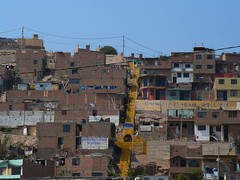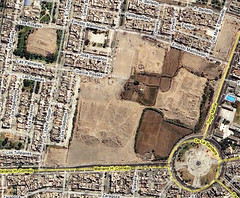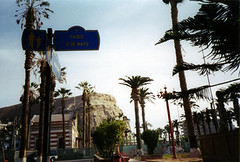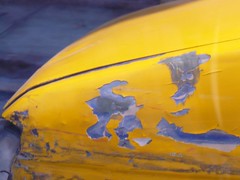Yanacocha mine in Cajamarca
By Kevin Maes
While I was staying up in Cajamarca, located in Peru’s northern Andean mountains, I heard the word Yanacocha, a word that popped out in conversations from time to time. It’s not a Spanish word, but it has a playful sound and for some reason it seemed rather important to everyone in Cajamarca. Well, as it turns out, they were talking about the Minera Yanacocha (Yanacocha Mine), which is not only important to the folks of Cajamarca. Minera Yanacocha just happens to be the largest gold mine in South America!
However, as Kavitha pointed out last week, the small local communities surrounding Yanacocha do not have running water, sewage, telephones or electricity! Should we be concerned that only 5% of the profits from these mines go to the local people, the rest mostly going to a US company? Should we be concerned about the environmental impact this mine has on the local people. Because I have been spending time in the town nearest the mine, I decided to find out more about the impact of this comany.
With over 65 metric tons of gold produced in 1996, Minera Yanacocha beats Brazil in product by a hair and Chile by a greater margin (It’s the ninth most productive gold mine in the world, and rates second for silver production, at 16%). Yanacocha is located about 20 miles north of Cajamarca at an altitude 13,120 feet above sea level. The mine was first started back in 1992, when geologists were sent into the mountainous region to study earth and determine which valuable minerals were present. After finding significant amounts of both gold and silver, the Minera Yanacocha began operating officially in August of 1993. Since then, it has produced significant amounts of zinc, copper, lead, tin, iron, mercury, and tungsten. The mine is also an important source of revenue, employment, and much controversy for the nearby town of Cajamarca and the rest of Peru.
Minera Yanacocha, owned by the US mining company Newmont, uses some of the most effective, yet questionable techniques of mining, even though the company claims these practices exceed the standards of typical Peruvian operations. Unfortunately, I was unable to visit the mine personally because of strict security and tourism quotas. However, I was able to speak personally to Marcos Valdez Cadenillas, the Director of Public Relations for Newmont. From both a lengthy discussion and video presentation, it was clear that the company is very sensitive to local and international concern about the major impact they have on the local environment.
The Minera Yanacocha covers a vast region. After geological testing, explosives are used to blow up areas of land, making the ground loose and ready for transport. Each of the three areas has a large, plastic pad. This pad is stretched out with a tubing system beneath it and dirt is piled into a large mound on top. The plastic pad contains an impermeable coating resistant to water and chemicals. A chemical element called cyanide is applied in quantity to the mound of dirt. The chemical has the ability to melt down any metallic substances it encounters as it passes down through the mound. As it reaches the bottom, it carries all of the metal, now in a liquid form, through the tubing system into a very large poso, or pool. From there, the liquid is pumped into the plant where the gold, silver, and other minerals are separated from the cyanide. Then, the land is washed down with water and drained out through the tubes and into the poso.
To read the original article, which continues with the methods the mine operations claim they implement to protect locals and the environment, and what the locals think, read here.
Tags: cajamarca, economy, environment, kevin maes, mining, newmont, yanacocha










